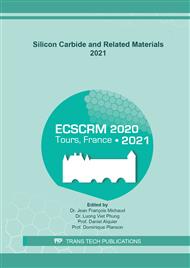[1]
A. Chatterjee, A. Bhat, K. Matocha, Investigation of electrically active defects of silicon carbide using atomistic scale modeling and simulation, Phys. B Condens. Matter, 401–402, (2007), 81–84.
DOI: 10.1016/j.physb.2007.08.118
Google Scholar
[2]
J. Woerle, B. C. Johnson, C. Bongiorno, K. Yamasue, G. Ferro, D. Dutta, T. A. Jung, H. Sigg, Y. Cho, U. Grossner and M. Camarda, Two-dimensional defect mapping of the SiO2/4H−SiC interface, Phys. Rev. Mater., 3, 8, (2019), 084602.
DOI: 10.1103/physrevmaterials.3.084602
Google Scholar
[3]
T. Kimoto, Z. Y. Chen, S. Tamura, S. I. Nakamura, N. Onojima and H. Matsunami, Surface morphological structures of 4H-, 6H- and 15R-SiC (0001) epitaxial layers grown by chemical vapor deposition, Jpn. J. Appl. Phys., 40, 5R, (2001), 3315–3319.
DOI: 10.1143/jjap.40.3315
Google Scholar
[4]
P. Fiorenza, F. Iucolano, G. Nicotra, C. Bongiorno, I. Deretzis, A. La Magna, F. Giannazzo, M. Saggio, C. Spinella, F. Roccaforte, Electron trapping at SiO2/4H-SiC interface probed by transient capacitance measurements and atomic resolution chemical analysis, Nanotechnology 29 (2018) 395702.
DOI: 10.1088/1361-6528/aad129
Google Scholar
[5]
M. Camarda, J. Woerle, V. Souliere, G. Ferro, H. Sigg, U. Grossner and J. Gobrecht, Analysis of 4H-SiC MOS Capacitors on macro-stepped surfaces, Mater. Sci. Forum, 897, (2017), 107–110.
DOI: 10.4028/www.scientific.net/msf.897.107
Google Scholar
[6]
D. Chaussende, L. Parent-Bert, Y. J. Shin, T. Ouisse and T. Yoshikawa, Effect of aluminum during the high temperature solution growth of Si-face 4H-SiC, Mater. Sci. Forum, 858, (2016), 37–40.
DOI: 10.4028/www.scientific.net/msf.858.37
Google Scholar
[7]
V. Soulière, D. Carole, M. Camarda, J. Woerle, U. Grossner, O. Dezellus and G. Ferro, 4H-SiC(0001) surface faceting during interaction with liquid Si, Mater. Sci. Forum, 858, (2016), 163–166.
DOI: 10.4028/www.scientific.net/msf.858.163
Google Scholar
[8]
U. Burr and U. Müller, Rayleigh-Bénard convection in liquid metal layers under the influence of a horizontal magnetic field, J. Fluid Mech., 453, (2002), 345–369.
DOI: 10.1017/s002211200100698x
Google Scholar
[9]
Y. Tasaka, T. Yanagisawa, K. Fujita, T. Miyagoshi and A. Sakuraba, 2D oscillation of convection roll in a finite liquid metal layer under a horizontal magnetic field, J. Fluid Mech., 911, (2021), 1–24.
DOI: 10.1017/jfm.2020.1047
Google Scholar
[10]
F. Mercier, J.-M. Dedulle, D. Chaussende and M. Pons, Coupled heat transfer and fluid dynamics modeling of high-temperature SiC solution growth, J. Crystal Growth 312 (2010) 155–163.
DOI: 10.1016/j.jcrysgro.2009.10.007
Google Scholar


